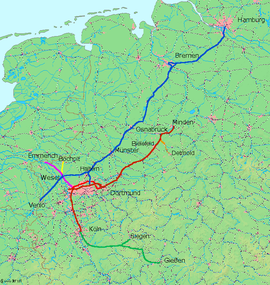History
On 18 December 1843, the Prussian government granted a concession to the trunk line to the Cologne-Minden Railway Company (German, old spelling: Cöln-Mindener Eisenbahn-Gesellschaft, CME) for the line, which began at what was then the CME station in Deutz (now a suburb of Cologne) with the construction of the first section to Düsseldorf, which was opened on 20 December 1845. Only a few weeks later, on 9 February 1846, the second section was completed to a temporary terminus at the site of present-day Duisburg Hauptbahnhof called the Cologne-Minden railway station, the first of three train stations built at the same place. [2]
The route of the next section to Oberhausen, Altenessen, Gelsenkirchen, Wanne, Herne and Dortmund to Hamm was chosen over a route close to the coal mines that were then located on the north bank of the Ruhr because it was cheaper to build as it largely avoided hills. Nevertheless, it still took well over a year until 15 May 1847 for this section to be completed and put into operation. On 15 October 1847 the last section was opened to Minden, thus completing the entire 263 kilometre long, single track railway. [2] On the same day the Royal Hanoverian State Railways opened its Hanover-Minden Railway, completing a connection to Berlin and northeastern Germany.
Rollbahn
Wanne station (now Wanne-Eickel Hbf) was from 1 January 1870, the starting point for a line to Hamburg called the Rollbahn (Rolling Line). This line along the German North Sea coast was part of the Paris-Hamburg Railway, linking with the CME’s concession from the Prussian government for a Hamburg-Venlo railway. [5]
Emscher Valley Railway
From 1871 to 1878 the CME built another line from Duisburg to Dortmund along the Emscher valley largely parallel to its trunk line via Osterfeld Süd and Wanne through the northern Ruhr to service the growing industries and prosperous coal mines. [6]
Services
Long distance trains only use parts of the line. The section from Duisburg to Oberhausen is served by Intercity-Express trains to and from Amsterdam. It is also served by Regional-Express trains on line RE 5 (Rhein-Express), terminating in Wesel, and RE19 (Rhein-IJssel-Express), terminating in Arnhem, and Regionalbahn line RB 35 (Emscher-Niederrhein-Bahn) between Gelsenkirchen and Mönchengladbach. Every two hours InterCity line 35 uses a large part of the line from Duisburg to Wanne-Eickel. In addition occasional trains of IC line 32, and at-least hourly regional services on lines RE 2 (Rhein-Haard-Express), RB 42 (Haard-Bahn) and RB 46 (Glückauf-Bahn) use the section from Gelsenkirchen to Wanne-Eickel.
The only Regional-Express service that uses the total length of the route is RE 3 Rhein-Emscher Express , which runs from Düsseldorf to Hamm, all on the route of the trunk line of the Cologne-Minden Railway Company.
S-Bahn line S 2 runs at 30-minute intervals between Herne and Dortmund Mengede and continues to Dortmund via the Southern route of the former Royal Westphalian Railway Company (Königlich-Westfälische Eisenbahn-Gesellschaft). West of Herne, one train per hour connects to Recklinghausen and one connects via Gelsenkirchen to Essen. Formerly another S-Bahn service per hour ran along the entire historic route between Duisburg and Dortmund. Since December 2019, this has operated as the RB 32 (Rhein-Emscher-Bahn), but running only on the Duisburg–Dortmund railway route, skipping the stations between Dortmund-Mengede and Dortmund. This is complemented by the RB 35 Emscher-Niederrhein-Bahn between Duisburg and Gelsenkirchen from Monday to Friday between 5 a.m. and 7 p.m. The RB 32 and RB 35 services stop at all stations between Duisburg and Gelsenkirchen, like the former S 2 service.
Duisburg Hauptbahnhof is a railway station in the city of Duisburg in western Germany. It is situated at the meeting point of many important national and international railway lines in the Northwestern Ruhr valley.

Oberhausen Hauptbahnhof is a railway station in Oberhausen, North Rhine-Westphalia, Germany. The station was opened in 1847 and is located on the Duisburg–Dortmund railway, Arnhem-Oberhausen railway, Oberhausen–Duisburg-Ruhrort railway and Oberhausen-Mülheim-Styrum railway and is served by ICE, IC, RE and RB services operated by Deutsche Bahn, Abellio Deutschland, NordWestBahn and Eurobahn.
Line S2 is a S-Bahn line in the Rhein-Ruhr network. It starts in Dortmund Hauptbahnhof and runs westerly. During weekdays one service per hour runs each to Essen Hauptbahnhof and Recklinghausen Hauptbahnhof using Stadler FLIRT 3XL units.
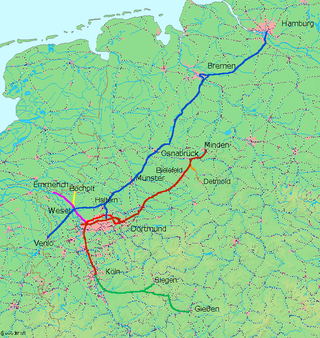
The 64 km long Cologne–Duisburg railway is one of the most important lines in Germany. It is the main axis for long distance and urban passenger rail services between Cologne and the Ruhr, served by Intercity Express, Intercity, Regional Express, regionalbahn and S-Bahn trains. It was the first section built of the Cologne-Minden trunk line and is one of the oldest railways in Germany. It was opened in 1845/46 and has been repeatedly modernized and expanded. Today the route comprises two or three double lines and is electrified throughout.
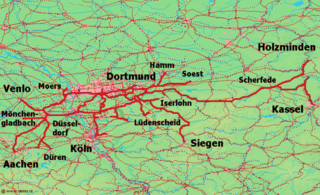
The Witten/Dortmund, Oberhausen/Duisburg railway is one of the most important railways in Germany. It is the main axis of long distance and regional rail transport on the east–west axis of the Ruhr and is served by Intercity-Express, InterCity, Regional-Express, Regionalbahn and S-Bahn trains.

Wanne-Eickel Hauptbahnhof is a railway station in the former city of Wanne-Eickel, now part of Herne in western Germany.

The Dortmund–Hamm Railway is an important and historically significant railway in Germany. It is a major axis for long distance passenger and freight trains between the Ruhr and the north and east of Germany. It is the part of the trunk line built by the Cologne-Minden Railway Company from Köln Deutz to Minden. It was opened in 1847 and has been modernized and developed several times since then.

The Cologne-Minden Railway Company was along with the Bergisch-Märkische Railway Company and the Rhenish Railway Company one of the railway companies that in the mid-19th century built the first railways in the Ruhr and large parts of today's North Rhine-Westphalia.

The Cologne-Minden trunk line is a railway built by the Cologne-Minden Railway Company. The line is the westernmost part of the railway line from Berlin to the Rhine that was proposed by Friedrich List in his Concept for a railway network in Germany, published in 1833. In fact, Friedrich Harkort had proposed the construction of a railway line from Cologne to Minden in 1825.

The Welver–Sterkrade railway is a former through railway line from the Westphalian town of Welver to Sterkrade in the western Ruhr region in Germany, which is now broken into four disconnected sections. Because its route ran along the Emscher river it was known as the Westphalian Emscher Valley Railway.
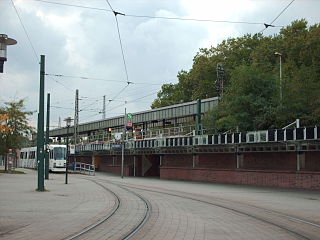
Essen-Altenessen is a railway station situated in Essen in western Germany. It is served by Regional-Express service RE3 (Rhein-Emscher-Express), Regionalbahn lines RB32 (Rhein-Emscher-Bahn) and RB35 (Emscher-Niederrhein-Bahn) and lines U11 and U17 of the Essen Stadtbahn.

The Rhein-Haard-Express is a Regional-Express service in the German state of North Rhine-Westphalia (NRW), running from Osnabrück via Münster, Recklinghausen, Gelsenkirchen, Essen and Duisburg to Düsseldorf.
The Gelsenkirchen Essen railway is a double-track, electrified main line railway in the central Ruhr area of the German state of North Rhine-Westphalia. It runs from Essen Hauptbahnhof via Essen-Kray Nord to Gelsenkirchen Hauptbahnhof.
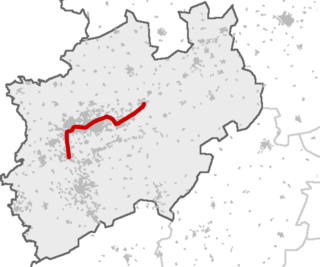
The Rhein-Emscher-Express is a Regional-Express service in the German state of North Rhine-Westphalia (NRW), running from Düsseldorf via Duisburg, Gelsenkirchen and Dortmund to Hamm. It connects with the rest of the regional rail network of NRW in Düsseldorf, Duisburg, Oberhausen, Wanne-Eickel, Dortmund and Hamm. In addition, it connects in Düsseldorf, Duisburg, Oberhausen, Dortmund and Hamm with long-distance services.
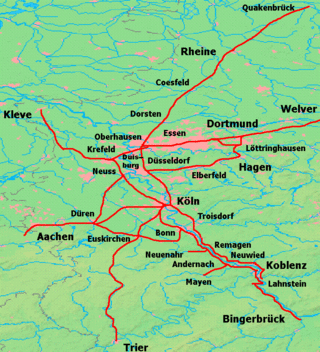
The Osterath–Dortmund-Süd railway is a historically significant line in the German state of North Rhine-Westphalia. Parts of it are closed, much of it is now used for freight only, but several sections are still used for Regional-Express, Regionalbahn or Rhine-Ruhr S-Bahn services.

Dortmund-Lütgendortmund station is a single-track, underground terminal station in the city of Dortmund in the German state of North Rhine-Westphalia. The platform is accessible by stairs, escalator or lift. It was opened in 1993 at the end of an extension of Line S 4 trains of the Rhine-Ruhr S-Bahn. Trains reverse here in order to return to Unna station. It is classified by Deutsche Bahn as a category 5 station.
The Duisburg-Ruhrort–Dortmund railway was built by the Cologne-Minden Railway Company in the area to the north of its original Ruhr line to improve connections to mines and factories in the northern Ruhr region, which is now in the German state of North Rhine-Westphalia.
The Bochum–Essen/Oberhausen railway was built by the Bergisch-Märkische Railway Company to the north of its main line through the central Ruhr to tap traffic from mines and factories in the northern Ruhr region, which is now in the German state of North Rhine-Westphalia.
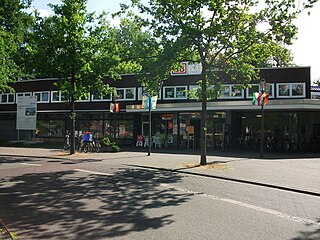
Dülmen station is one of two operating tower stations in the German state of North Rhine-Westphalia. It is located in Dülmen in western Münsterland. It is at the crossing of the Wanne-Eickel–Hamburg and the Dortmund–Enschede railways.
The Emscher-Niederrhein-Bahn (RB 35) is a Regionalbahn service in the German state of North Rhine-Westphalia. It runs hourly between Gelsenkirchen and Duisburg with Mönchengladbach. Its name refers to the Emscher river and the Lower Rhine.
